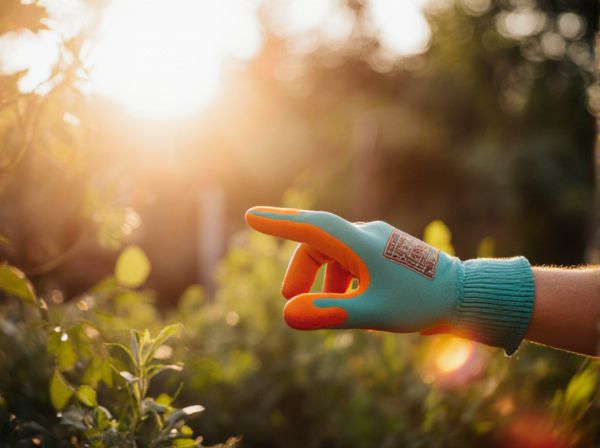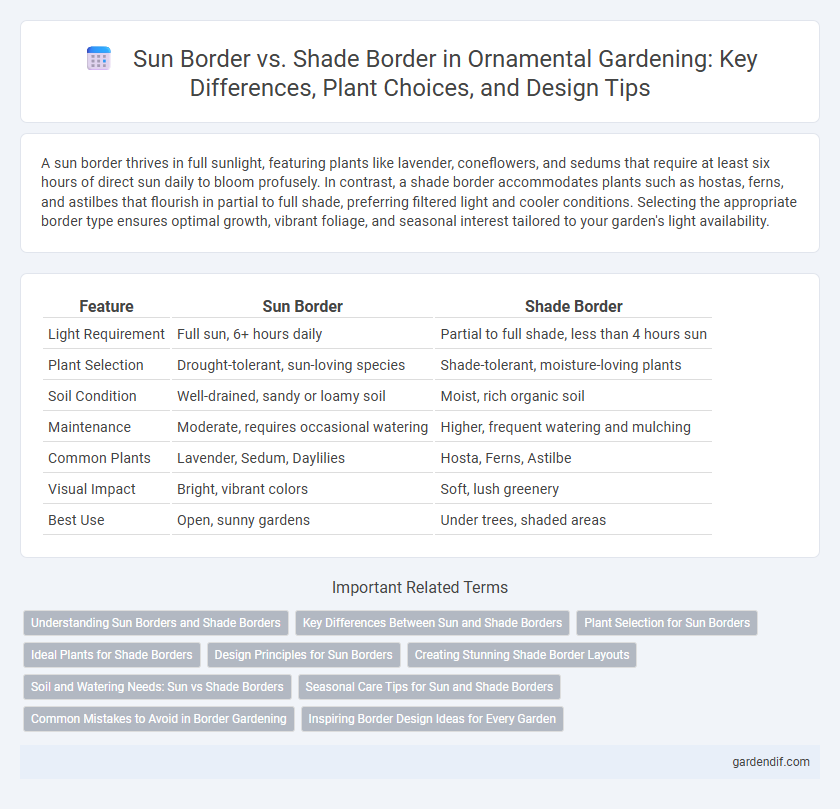
Sun Border vs Shade Border Illustration
A sun border thrives in full sunlight, featuring plants like lavender, coneflowers, and sedums that require at least six hours of direct sun daily to bloom profusely. In contrast, a shade border accommodates plants such as hostas, ferns, and astilbes that flourish in partial to full shade, preferring filtered light and cooler conditions. Selecting the appropriate border type ensures optimal growth, vibrant foliage, and seasonal interest tailored to your garden's light availability.
Table of Comparison
| Feature | Sun Border | Shade Border |
|---|---|---|
| Light Requirement | Full sun, 6+ hours daily | Partial to full shade, less than 4 hours sun |
| Plant Selection | Drought-tolerant, sun-loving species | Shade-tolerant, moisture-loving plants |
| Soil Condition | Well-drained, sandy or loamy soil | Moist, rich organic soil |
| Maintenance | Moderate, requires occasional watering | Higher, frequent watering and mulching |
| Common Plants | Lavender, Sedum, Daylilies | Hosta, Ferns, Astilbe |
| Visual Impact | Bright, vibrant colors | Soft, lush greenery |
| Best Use | Open, sunny gardens | Under trees, shaded areas |
Understanding Sun Borders and Shade Borders
Sun borders thrive in full sunlight, supporting heat-tolerant, drought-resistant plants like lavender, salvia, and ornamental grasses. Shade borders require plants adapted to lower light levels, such as hostas, ferns, and astilbes, which flourish under tree canopies or shaded garden areas. Proper selection of sun border and shade border plants enhances garden aesthetics, promotes healthy growth, and reduces maintenance needs.
Key Differences Between Sun and Shade Borders
Sun borders feature plants that thrive in full sunlight, such as lavender, coneflowers, and daylilies, which require at least six hours of direct sun daily. Shade borders are designed for areas with limited sunlight, favoring shade-loving plants like hostas, ferns, and astilbes that flourish in filtered or indirect light. The key differences lie in plant selection based on light tolerance, soil moisture needs, and seasonal color displays, making the choice critical for garden health and aesthetic appeal.
Plant Selection for Sun Borders
Sun borders require plants that thrive in full sunlight and can tolerate dry conditions, such as lavender, salvia, and ornamental grasses, which offer vibrant colors and textures. Choosing drought-resistant perennials like echinacea and gaura ensures long-lasting blooms and minimal maintenance. Incorporating hardy sun-loving shrubs like roses or buddleia enhances structure and seasonal interest in a sun border.
Ideal Plants for Shade Borders
Ideal plants for shade borders include hostas, ferns, and astilbes, which thrive in low-light conditions and add texture and color to shaded garden areas. Shade borders benefit from species like heucheras and hellebores that provide year-round interest with their diverse foliage and early blooms. Incorporating native shade-tolerant plants such as Solomon's seal and foamflower enhances biodiversity and supports local ecosystems.
Design Principles for Sun Borders
Sun borders require plants that thrive in full sunlight, emphasizing drought tolerance and heat resistance to ensure longevity and vibrant growth. Design principles prioritize layering with taller sun-loving perennials at the back and shorter, colorful annuals or groundcovers in front to create depth and continuous bloom cycles. Incorporating contrasting textures and foliage colors enhances visual interest while maintaining ecological harmony and low maintenance needs.
Creating Stunning Shade Border Layouts
Creating stunning shade border layouts requires careful selection of plants that thrive in low-light conditions, such as hostas, ferns, and astilbes, which provide diverse textures and vibrant foliage. Using a mix of evergreen shrubs and perennials ensures year-round interest while emphasizing contrast between leaf shapes and colors to enhance visual appeal. Incorporating layered planting techniques and strategic focal points like shade-tolerant flowering plants adds depth and dimension to shade gardens, setting them apart from sun borders.
Soil and Watering Needs: Sun vs Shade Borders
Sun borders typically thrive in well-drained, nutrient-rich soil with consistent moisture, requiring regular watering to support sun-loving plants like lavender and salvia. Shade borders demand soil that retains moisture longer, often enriched with organic matter to nourish shade-tolerant species such as hostas and ferns, needing less frequent but deeper watering. Understanding these soil and watering needs ensures robust growth and vibrant ornamental displays in both sun and shade garden borders.
Seasonal Care Tips for Sun and Shade Borders
Sun borders require regular watering during dry periods and deadheading to promote continuous blooming, with seasonal fertilization in spring and mid-summer to support vigorous growth. Shade borders benefit from mulching to retain soil moisture, pruning to remove dead foliage, and the application of slow-release fertilizer in early spring to enhance shade-tolerant plant health. Monitoring for pests and diseases is essential in both border types, especially during humid conditions in late summer.
Common Mistakes to Avoid in Border Gardening
Sun borders often face common mistakes like overcrowding sun-loving plants or neglecting soil drainage, which can hinder growth and cause foliage damage. Shade borders frequently suffer from improper plant selection, such as choosing sun-dependent species, leading to poor establishment and health issues. Ensuring correct plant placement according to light requirements and maintaining appropriate watering practices are critical steps to avoid these frequent border gardening errors.
Inspiring Border Design Ideas for Every Garden
Sun borders thrive with vibrant, drought-tolerant plants such as lavender, sedum, and ornamental grasses, creating bold and colorful garden edges that attract pollinators and require minimal maintenance. Shade borders flourish with lush, moisture-loving species like hostas, ferns, and astilbes, offering textured greenery and soft floral accents that enliven darker garden areas. Combining both sun and shade border design ideas enhances garden diversity, provides year-round interest, and maximizes planting potential in varied light conditions.
Sun Border vs Shade Border Infographic

 gardendif.com
gardendif.com